Scaling Mont Blanc
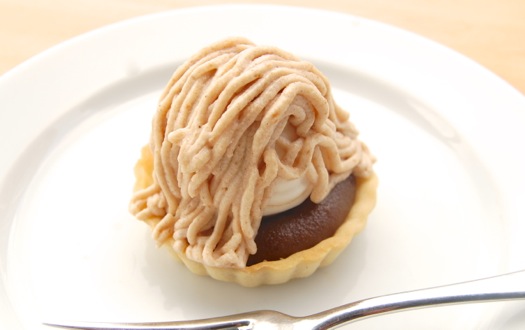
Mont blanc is a classic squiggle-covered pastry, designed to be evocative of a mountain (that is, Mont Blanc). It makes a blockbuster closer to an elegant meal. In fact it’s almost tailor made for these sorts of occasions since nearly all the components need to be made ahead of time, sequentially. Make one every day or so for a few days and you’ll find you can whip together a dozen servings in the time it takes your spouse to clear the table.
Alternately you can do like the Continentals do and skip the “afters” idea and just enjoy one in the middle of the afternoon. It’s what I did and I can’t say I regretted it. Mont blanc is sweet, not terribly rich and full of old school pastry charm. Have a look at the recipe to get your game plan together.
On my first day I made the meringue cookies. I put the French meringue into a piping bag with just the collar, no tip, and extruded these little heaps. I tamped down the points with a wet finger, then baked them in a 250 degree (Fahrenheit) oven for an hour, then lowered the heat to 200 and baked them another hour. I cooled them completely and stored them in an airtight container.
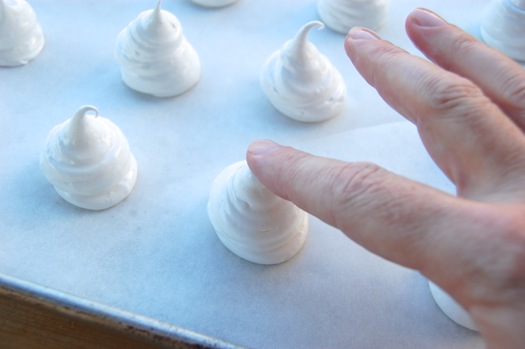
On the next day I made the tartlet crusts. I prepared the dough and let it sit for an hour in the refrigerator to hydrate, then rolled it on a well-floured board to a thickness of about 1/8″. Then, using a cutter from my round cutter set, I cut 3 3/4″ circles.
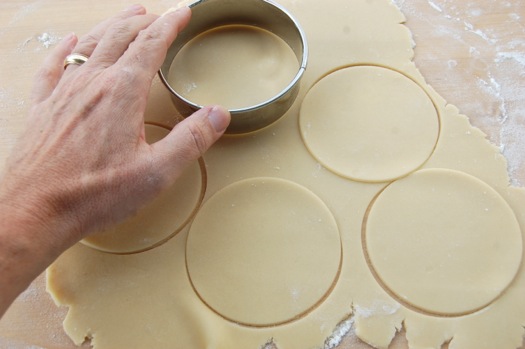
Which fit into my standard 3″ tartlet molds just perfectly.
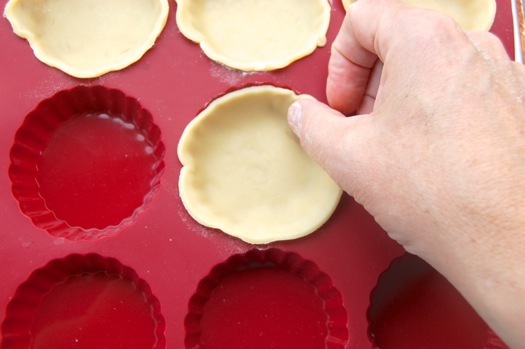
‘Course I needed to trim them up a bit. I put them in the fridge to relax for an hour, and meanwhile I preheated my oven to 375 degrees Fahrenheit. I baked them about 12 minutes until they were lightly golden. I cooled them completely and stored them on a plate on the counter until today. I could have frozen them for a couple of weeks had I wanted to do that, but I was on a schedule.
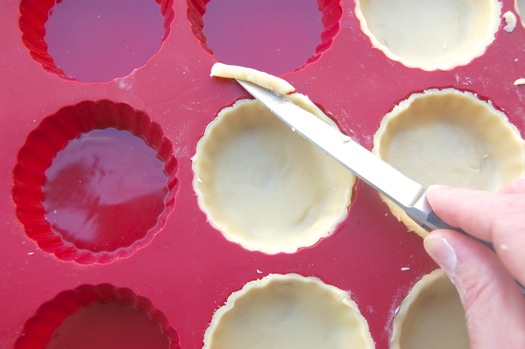
Today I got out my pre-baked tartlet crust and put it on a plate.
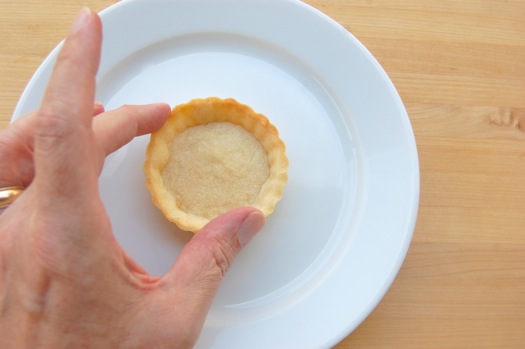
I put the chestnut spread in a pastry bag fitted with a collar but no tip and piped a nice quantity of that delicious stuff into the crust.
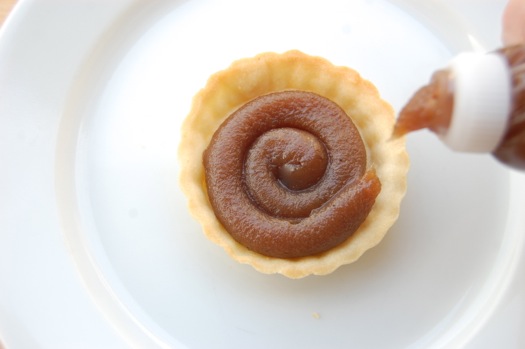
I then arranged a meringue cookie on top. Looks good enough to eat, no?
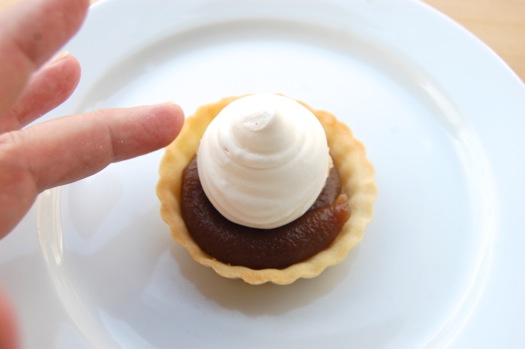
But the best was yet to come. I combined more chestnut spread with my boozy Chantilly cream in about a 1-1 proportion, erring on the side of more cream (you can also use buttercream for firmer vermicelli and a richer overall effect). I used about a cup of each, then gently folded them together. Photo not shown because, quite simply, I flaked.

I loaded that into a pastry bag fitted with a Wilton #234 tip and an extra-large collar, which you need for that thing. There’s upwards of seven dollars worth of gear here.
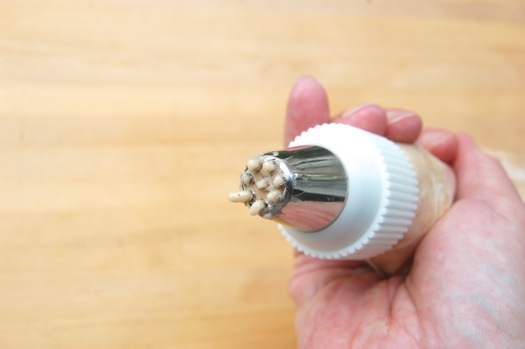
With slow, steady back-and-forth motions I piped my chestnut cream vermicelli on top. In pastry shops the lines are perfectly straight. Me, I’m not that good a piper, but my diners will survive the experience I think.
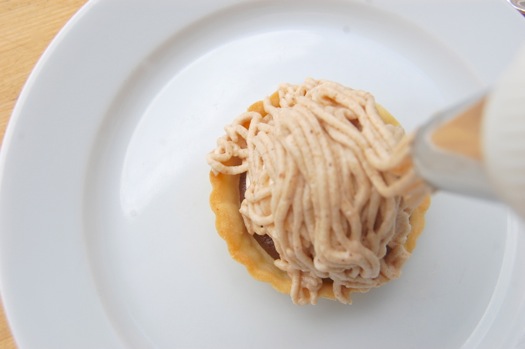
And that, as they say, was that. Except I forgot to dust the top with a little powdered sugar “snow”. Ah well, you can’t have everything.

I planted a flag at the summit and called it a success.
Very nice Joe, I’m tempted to try this myself, all I need to find is the chestnuts and/or paste.
Then again, if all you have is walnuts, why not walnut flavoured Mont Blanc 🙂
Thanks, Warren! And indeed why not make yours using walnut butter! I’ll come over for coffee and pastry, natch!
– Joe
It would be prettier if you swirled the piping on top rather than using a back and forth motion.
But, but…I like the draped-over effect! That way it looks more like a mountain, and more like what I remember from Parisian shops. Mont blanc is not known as a handsome pastry, it’s supposed to be a little homely. But do as you will…to each their own, I say!
I should add that in that case you might want to make disks of meringue instead of the mountain peaks I made. The birds nests of vermicelli will sit more securely on top!
Cheers,
– Joe
They look magnificent! I shall endeavor to conquer that peak!
But alas, I am on a budget here, dividing a set amount amongst five or six varying interests ranging from artisan cheese making to adult hockey league (never the two shall meet) and I have but a wee question. Having used about a cup of the chestnut spread in the vermicellis and perhaps a bit more layered below the meringue cookie, how much, if any, of the chestnut spread was left over and could it be frozen until the Holidays?
Hey Dave!
It depends on how many you make, of course. I used chestnut spread, which is a little cheaper. If you only make four or so at a time you’ll probably only use half the can at a pop. And in fact the vermicelli are better if you use more cream than chestnut paste. Fold in a little, and beat a tablespoon or so of cognac into the Chanitlly cream as you go and you’ll be even better off! Oh, and you can store the leftovers in the freezer.
Have fun!
– Joe
Joe, I’m really impressed at how your tart shells don’t look like they shrunk, nor did they puff up undesirably, despite apparently not being baked blind. What’s your secret?! I have not tried your tart crust recipe, but I occasionally modify my standard short-crust with an egg in place of water, plus a bit of sugar; however, the result is usually more crumbly and heading in cookie direction than I generally like pastry to be – it becomes almost a crostata-type crust, which I don’t love. Yours, though, appears to be light and crisp, yet also clearly retains its shape. That can’t be totally owing to the touch of cream, can it? Is it the corn starch in the icing sugar that makes the difference? Thanks!
Hey Jen!
Thanks very much. These did shrink a little, though not terribly much, and while I do get some bubbles in the corners of some of them (I always pick the better ones for shots) they don’t puff up very much as a rule.
All of which is to say that the gluten is pretty well defeated. Much of that comes from the ingredients: fats, sugars, emulsifiers. However the other key ingredient is time. The longer you rest the dough, whenever you work it, the better. I rested the original dough overnight, then the shaped crusts for about three hours, which made a difference. If you can stand to wait, in other words, you get a superior product.
That’s what I know! Cheers,
– Joe
Thanks, I will exercise patience on my next batch of tarts 🙂
Let me know how they go!
– Joe
Hey Joe,
So which recipe do you end up prefering? The traditional one or the upscale one? I would be very interested to get a comparison in terms of texture and flavors…
Also, just wanted to let you know that in the original Mont Blanc recipe, you would usually add just a bit of dark alcohol to the chestnut paste (usually cognac but could be rhum). It definitely give another kick (if necessary ;)) to this amazing desert.
Cheers,
Amandine
Hi Amandine!
The version I did tasted very similar, though the extra amount of chestnut spread at the bottom made it more substantial (in a good way). The first version I tried was very sweet and airy which was nice. I liked this direction for a number of reasons. But try your own and see what you think (and get back to me with the results).
And those are great tips! I meant to add a little cognac or bourbon or something, but forgot!
– Joe
I should also say that this some what more substantial version is better in a smaller portion, though that’s probably obvious. Though I like to make a lot of sweet things, I really don’t like big portions, especially after a meal, so these 3″ tartlets were really perfect.
Did you read the story about the climber who recently found a treasure of jewels on Mont Blanc? I won’t be surprised if a modernist version of the desert appears in France soon with some chopped candied fruits right there in the tartlet :).
http://edition.cnn.com/2013/09/26/world/europe/france-mountain-jewels/index.html
I had not heard about that…amazing!
Thanks, Dani!
– Joe